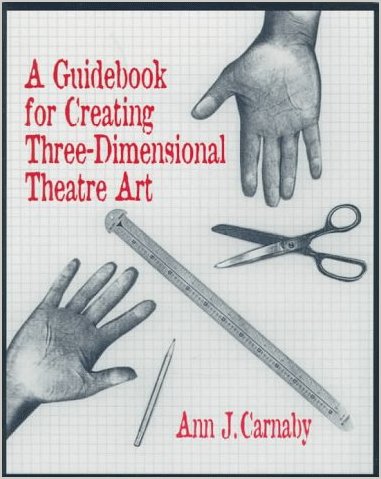
A Guidebook for Creating Three-Dimensional Theatre Art, by Ann J. Carnaby, is quite the mixed-bag in terms of books about props.
First let me start with the good. The first chapter is probably one of the best-written texts on developing an approach to building those props you need to build which you’ve never built before. It is one of the reasons I got this book. When I began writing my own book and working on my presentation for the 2009 SETC Theatre Symposium, I discovered this book; after reading the first chapter, I recognized the similarities in our approach and knew I was on to something.
The second chapter on safety is also wonderfully comprehensive and useful for the theatre artist.
It is after that when the problems begin. This is a good idea for a book, and that’s what the majority of it feels like: an idea. The writing is chopped up into so many bullet points and little blurbs that it never feels like more than an outline or book proposal. The interesting parts are not fleshed out enough, and the uninteresting parts are given an equal amount of room. Even the layout is troubling; this book has so much white space (some pages have only a handful of words), that were it removed, it would probably be more like a large pamphlet rather than a whole book. The first two chapters show so much potential, with an author who obviously knows her props, while the rest reads like a poorly-made PowerPoint slideshow. And let’s be honest; no one can make a PowerPoint slide sound interesting.
Speaking of layout, should I mention that the headings throughout the book use a font that looks suspiciously like Comic Sans? That, along with sample projects like cow masks and elf shoes, promise a certain amount of quirkiness, but the text itself remains dry and humorless.
Perhaps all of this could be forgiven if the photographs and illustrations were well made. Alas, this is not so. Even the largest pictures are no bigger than a wallet-sized photo, and they are all in black and white. Some are so washed out you cannot make out the details, while others are left with no context; for example, a photograph of a “shampoo bottle costume” shows a costume without a person inside of it, so it looks like a regular shampoo bottle. With a plain background, you cannot even discern the size. Some of the sections do not even have photographs. This may be forgivable in the chapter on materials; a picture of “muslin” would be nice, but not necessary. However, there are a few projects which do not even include a picture. With the descriptions sparse as it is, neglecting to include a photograph makes one wonder why the project was even included.
Since I mentioned the chapter of materials, I’d like to mention another problem I have with this book. In a seemingly random collection of materials one would use for making props, the book lists generic materials alongside brand-name products. So one page will talk about urethane foam, while the next page discusses Sculpt or Coat. The whole chapter reads more like the contents of one’s supply cabinet rather than a comprehensive overview of the materials available to a props artisan. Without placing a product like Sculpt or Coat within the context of materials, you make the discussion irrelevant to an artisan who lives in an area where one cannot buy Sculpt or Coat, or it becomes obsolete when the brand goes out of business. Finally, I just have to point this out: the book lists “backpack frame” as a material. Really?
I do not mean to heap complaints onto this book, but I feel I need to give a fair review. The final major problem I have with this book is its lack of focus shown by its choice of projects. Of the 31 projects, 7 are “animal heads” and 7 are crowns/hats. The rest of the projects include costumes, a puppet, shoes, some masks among other random props. It feels like the projects want to be either more general, or more specialized. If one is interested in learning more, there exist books on any of these project types that explain the processes far better. Perhaps if the projects were more exemplary, this type of hodge-podge collection could be overlooked (Thurston James’ Theatre Props Handbook takes a similar scatter-shot approach in the materials and techniques it explains, but makes up for it in its wit and sheer amount of knowledge it contains), but one of the projects is literally hot-gluing flowers to a costume.
I don’t know what it is about books about theatrical props where even when a talented artisan is involved, the end result feels cheap, shoddy and incomplete. You only have to browse the crafts section of any bookstore to see any number of trite and instantly forgettable books which are nonetheless chock full of beautiful full-color photography and clear writing. If you are looking for general books about theatrical prop-making, you would be better off with Andy Wilson’s Making Stage Props, James’ Molding and Casting Handbook, or even his aforementioned Theatre Props Handbook. If you want more focused books on specific crafts, such as millinery, puppets or costume crafts, you can find any number of books with far better instructions.
